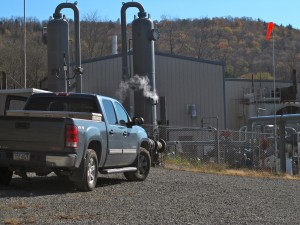Federal court weighs in on air emissions controversy in Pa. gas fields
-
Susan Phillips

Katie Colaneri/StateImpact Pennsylvania
A compressor station pumps natural gas into the Tennessee Pipeline in Dimock, Pa.
A federal court weighed in on a contentious debate over air emissions from Pennsylvania’s oil and gas sector this week. In Citizens for Pennsylvania’s Future v. Ultra Resources Inc., Pennsylvania’s Middle District Court ruled against the environmental group, more commonly known as PennFuture, and in favor of the gas company. But in the 31-page decision, U.S. District Judge Robert Mariani laid out for the first time in this region, how state environmental regulators can make sure natural gas companies can comply with the Clean Air Act without gaming the system.
The issue is how to determine what’s known as “aggregation,” or combining multiple pollution sources into one, something allowed under the federal Clean Air Act. Typically, it’s a tool that industry doesn’t like. That’s because when smaller sources of air pollution become regulated as one large source of air emissions, they can be subject to stricter regulatory standards. It also triggers a lengthier review process by state regulators, and subsequently, could mean more public input. If the Department of Environmental Protection decides that a company’s natural gas facilities are aggregated, this tends to force gas drillers to install more pollution controls than would be the case otherwise.
Environmental groups like the Clean Air Council and PennFuture have argued that the DEP should aggregate natural gas facilities, thereby forcing the gas companies to comply with stricter air emissions standards. In this case, PennFuture objected to Ultra Resources building a series of eight compressor stations, which help move natural gas along pipelines, without pulling a permit that would have those facilities aggregated into one source. Ultra Resources instead applied for permits for each compressor station, located in Tioga and Potter counties, and the Department of Environmental Protection granted them. In 2011, PennFuture filed suit, saying when combined, the compressor stations emitted more than 100 tons of nitrous oxide each year, and should be subject to the more stringent regulatory regime as a major source.
Pennsylvania enforces the Clean Air Act under guidance from the U.S. Environmental Protection Agency. But the feds defer to the state regulators. Under the Corbett Administration, the two publicly disagreed on how to determine aggregation of pollution sources in the Marcellus Shale gas fields.
Aggregation has to meet a three-tiered test that sounds simple but can become complex. The three criteria are:
- Whether the activity is within the same industry
- Whether the facilities are located on one or more adjacent or contiguous properties, and
- Whether they are under control of the same entity, or company. The EPA has interpreted adjacent or contiguous property to include an analysis of “interdependence.”
But the definitions of both “adjacent” and “interdependent” can be open to interpretation. Back in 2012, a federal court in Michigan ruled in a similar case that the EPA should only consider adjacency, and not interdependence. This weeks decision by the middle district court is the first time a federal court in Pennsylvania has rendered a decision on aggregation. In this case, Ultra Resources argued that their facilities were far enough apart not to be adjacent, and they were not interdependent. PennFuture argued that because the compressor stations all fed into the same natural gas meter, they were interdependent. But the compressor stations were not all connected by one pipeline. And so the court agreed with the defendant by ruling that these particular compressor stations, as a fact, were neither adjacent nor interdependent.
But Justice Mariani did leave open the possibility that DEP could and should consider interdependence, and not simply decide aggregation based on the adjacency of the facilities.
…Plaintiff has not pointed to any record facts to demonstrate that Ultra’s individual facilities are in any way unusual or outside of the normal oil and gas configurations and arrangements contemplated by PADEP.
Nonetheless, the Court recognizes the risk that a strict application of the plain meaning of the terms “adjacent” and “contiguous” may allow oil and gas exploration and production companies to manipulate or structure their wells and compressors in such a technical way as to avoid being deemed a “major” source, including by avoiding the aggregation of their wells and compressors.
PennFuture attorney Mark Szybist doesn’t view the court’s decision has a complete loss.
“We didn’t succeed in compelling Ultra to get a major source permit,” said Szybist. “But it was a victory for the citizens and the DEP in so far as it affirms that interdependence matters and the DEP may and should take it into account, which should result in more careful review of these facilities by DEP.”
In other words, despite the loss, Szybist says the ruling upholds DEP’s authority to consider interdependence as a factor, and not simply physical adjacency of natural gas facilities, when it comes to major source pollution determinations.
Efforts to reach Ultra Resources, and their attorneys were unsuccessful. An article posted on the Babst Calland website, the law firm that represented Ultra Resources in this case, said that despite the ruling, debate over air quality permits for oil and gas sites in Pennsylvania would continue.
While the Court left some room for the consideration of functional relationships in making single source determinations, such a determination would need to have unique facts that are outside the normal oil and gas configurations contemplated by DEP.
















